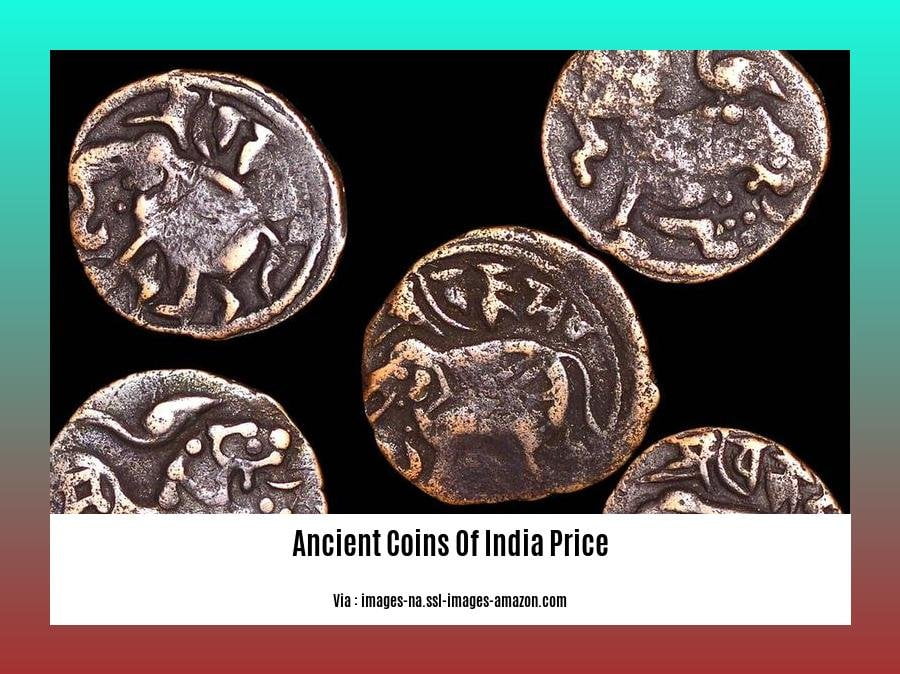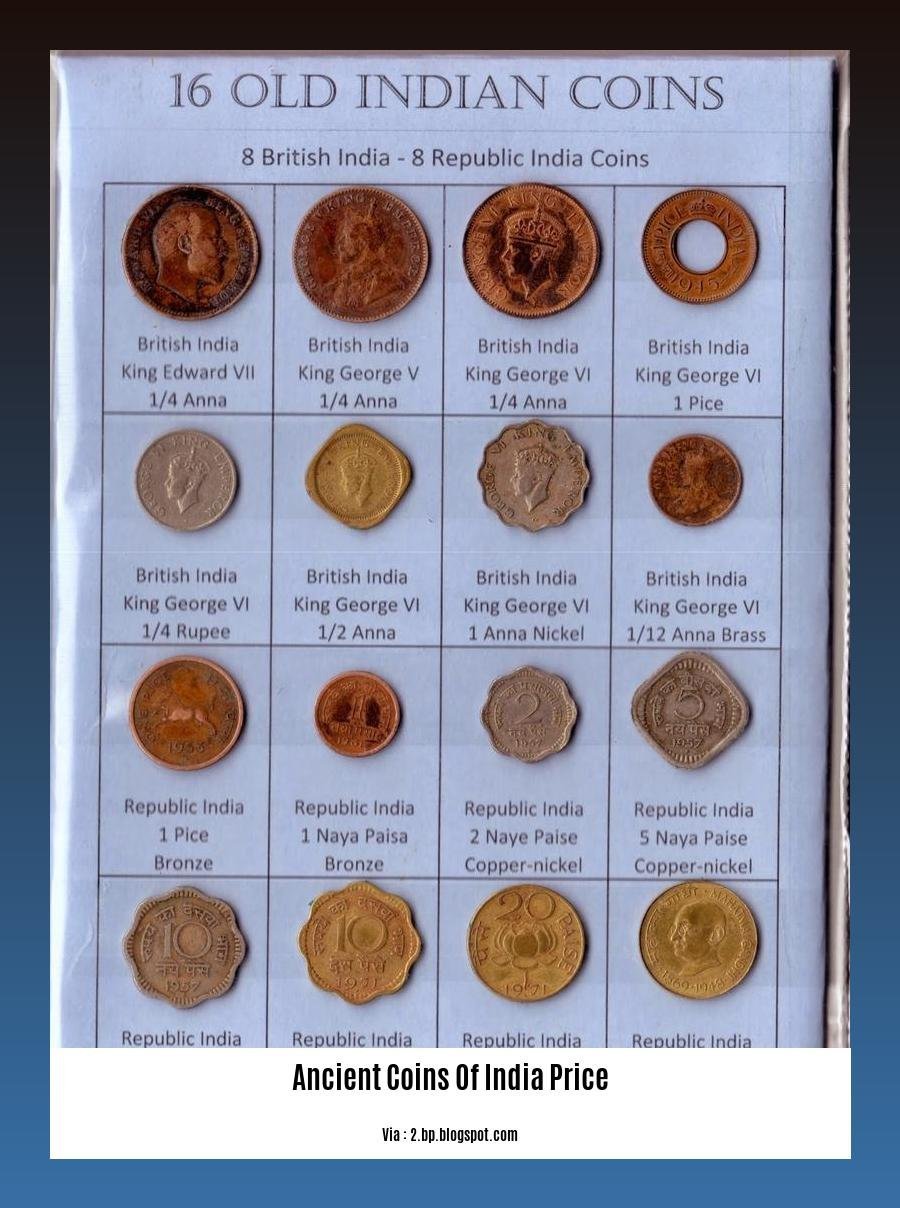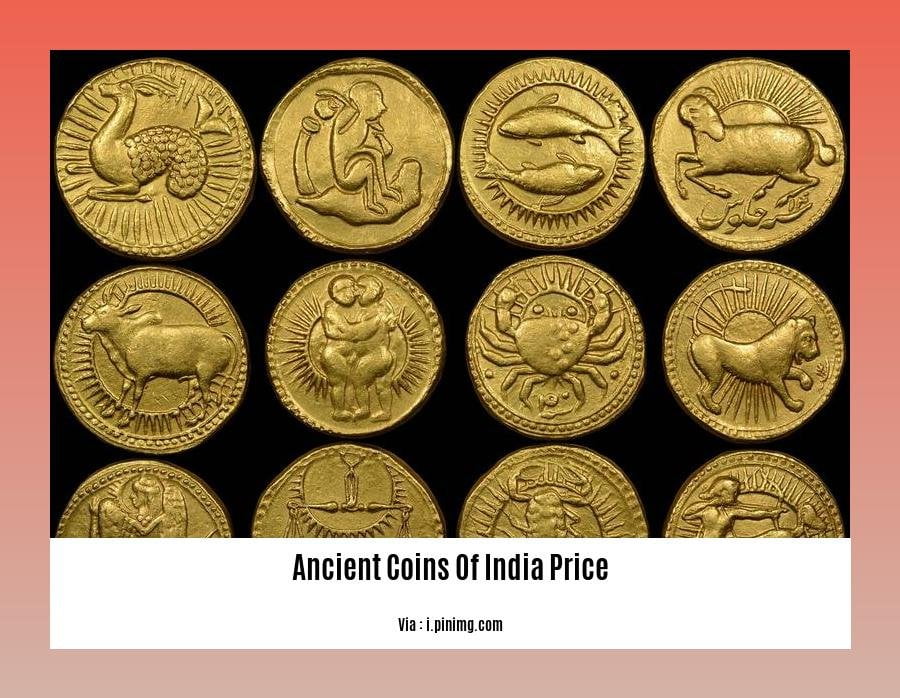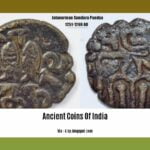Discover the captivating world of ancient Indian coins and delve into their historical significance and market value in [[Ancient Coins of India Price]: Unveiling the Value of Historical Treasures]. As we embark on this numismatic journey, we’ll explore the intricate designs, rich symbolism, and captivating inscriptions that adorn these coins, providing a glimpse into India’s glorious past. Whether you’re a seasoned collector, a curious enthusiast, or simply seeking knowledge, this article promises to illuminate the worth of these ancient treasures.
Key Takeaways:
Ancient Coins: The earliest coins known as punchmarked Karshapanas originated in the lower Ganges valley around 600 BCE.
Origin of Indian Coins: The creation of Indian coins is estimated to have occurred between 1000 BCE and 500 BCE, though the exact timeframe is debated.
Variety of Coins: Ancient India produced diverse coins. Made from metals such as copper, silver, and occasionally gold. Each kingdom or empire issued coins with unique designs and inscriptions offering historical and cultural insights. .
Usage and Trade: Ancient Indian coins served multiple purposes. They were used for trade, economic transactions, and offerings in religious rituals. These coins played a crucial role in facilitating commerce and establishing economic systems.
Ancient Coins of India Price: Unveiling the Value of Historical Treasures

For enthusiasts and collectors, ancient Indian coins hold immense historical and cultural significance. Their value extends beyond mere monetary worth, encompassing the rich heritage and craftsmanship of ancient India. Understanding the factors that determine the ancient coins of India price can provide valuable insights into their significance and help collectors make informed decisions.
Factors Influencing Ancient Coins of India Price:
Rarity: Scarcity plays a crucial role in determining the ancient coins of India price. Rare coins, especially those with unique designs or historical importance, often command higher prices.
Condition: The preservation and condition of the coin significantly impact its value. Coins in excellent condition, exhibiting minimal wear and tear, are generally more valuable than those with visible damage or deterioration.
Historical Significance: Coins associated with pivotal historical events, influential rulers, or notable dynasties tend to carry a premium. The historical context and stories behind these coins enhance their value.
Artistic and Design Elements: The artistry and design of ancient Indian coins often reflect the cultural and artistic influences of the period. Coins with intricate designs, unique symbols, or well-preserved inscriptions are highly sought after and command higher prices.
Metal and Composition: The type of metal used in minting the coin also influences its value. Gold and silver coins, due to their intrinsic value and rarity, typically fetch higher prices compared to copper or bronze coins.
Demand and Supply: Market forces of supply and demand also impact the ancient coins of India price. Coins that are in high demand due to their rarity or historical significance tend to command higher prices, while coins with a limited collector base may have lower values.
Understanding these key factors provides collectors with a framework for assessing the value of ancient Indian coins. By considering the rarity, condition, historical significance, artistic merit, metal composition, and market demand, collectors can make informed decisions and appreciate the true value of these historical treasures.
Discover the intricate hierarchy and structure of ancient Chinese military ranks by delving into the depths of our comprehensive guide. / ancient chinese military ranks
Journey through the ancient coins of India, where intricate designs and historical significance intertwine, offering a glimpse into the rich past of this vibrant land. / ancient coins of india
Immerse yourself in the fascinating world of ancient fishing methods, where ingenuity and resourcefulness prevailed, shaping the traditions and practices that continue to inspire modern angling techniques. / ancient fishing methods
Factors affecting coin value
Ancient Indian coins are captivating artifacts that hold historical, cultural, and numismatic significance. Their value is influenced by various factors that collectors and enthusiasts consider when determining their worth. Let’s delve into these factors and understand their role in shaping the value of these remarkable coins:
Rarity
The scarcity of a coin plays a crucial role in determining its value. Rare coins, especially those with limited mintage or unique designs, are highly sought after by collectors and command premium prices. The rarity of a coin is often determined by its age, historical significance, and the number of surviving pieces.
Condition
The condition of a coin significantly impacts its value. Coins in excellent condition, exhibiting minimal wear and tear, are generally more valuable than those with signs of damage or deterioration. Factors such as surface preservation, strike quality, and the presence of mint luster contribute to the overall condition of a coin and influence its market value.
Historical Significance
Coins associated with pivotal historical events, influential rulers, or notable dynasties carry a premium. Coins that commemorate special occasions, mark important anniversaries, or bear the effigies of renowned historical figures are often highly valued by collectors and historians alike. The historical significance of a coin adds to its desirability and contributes to its numismatic value.
Artistic and Design Elements
The artistic and design elements of a coin also influence its value. Coins with intricate designs, unique symbols, or well-preserved inscriptions are highly sought after. The artistry and craftsmanship exhibited in the design of a coin add to its aesthetic appeal and enhance its desirability among collectors.
Metal and Composition
The metal used in the production of a coin and its composition play a role in determining its value. Gold and silver coins, due to their intrinsic value and rarity, typically fetch higher prices. However, coins made from other metals, such as copper and bronze, can also be valuable, especially if they are rare or historically significant.
Demand and Supply
Market forces of supply and demand also impact the prices of ancient Indian coins. Coins in high demand due to rarity or historical significance command higher prices. Conversely, coins that are more common or have a limited collector base may have lower values. The dynamics of supply and demand can fluctuate over time, influencing the market value of specific coins.
Key Takeaways:
Rarity: Rare coins with limited mintage or unique designs are highly sought after and command premium prices.
Condition: Coins in excellent condition, with minimal wear and tear, are more valuable than those with signs of damage or deterioration.
Historical Significance: Coins associated with pivotal historical events, influential rulers, or notable dynasties carry a premium.
Artistic and Design Elements: Coins with intricate designs, unique symbols, or well-preserved inscriptions are highly sought after.
Metal and Composition: Gold and silver coins typically fetch higher prices due to their intrinsic value and rarity.
Demand and Supply: Market forces of supply and demand influence the prices of ancient Indian coins, with rare and historically significant coins commanding higher prices.
Sources:
Ancient Coins of India: Know Values and Usage of Ancient Coins
Ancient Coins of India Chart: 10 Coin Name!
Buying and selling ancient Indian coins

Have you ever considered buying and selling ancient Indian coins? These relics of a bygone era offer a fascinating glimpse into India’s rich history and culture. Let’s delve into the world of ancient Indian coins and explore their significance and value.
Key Takeaways:
- Ancient Indian coins, dating back to the 6th century BCE, hold historical, cultural, and numismatic significance.
- Factors like rarity, condition, historical context, and artistic elements determine the value of ancient Indian coins.
- Research, authentication, and dealing with reputable sellers are crucial for successful buying and selling ancient Indian coins.
- Online platforms, coin shows, and reputable dealers provide avenues for buying and selling ancient Indian coins.
- Proper care and storage ensure the preservation and value of ancient Indian coins.
Historical and Cultural Significance:
Imagine holding a coin that was once used during the Mauryan Empire or the Gupta Empire. These coins are tangible links to ancient India’s political, economic, and cultural landscape. They depict rulers, deities, symbols, and inscriptions that provide insights into the art, trade, and religious beliefs of those times.
Determining Value:
The value of ancient Indian coins is influenced by several factors:
- Rarity: Rare coins, especially those with unique designs or historical significance, command higher prices.
- Condition: Coins in excellent condition, exhibiting minimal wear and tear, are generally more valuable.
- Historical Significance: Coins associated with pivotal historical events, influential rulers, or notable dynasties carry a premium.
- Artistic and Design Elements: Coins with intricate designs, unique symbols, or well-preserved inscriptions are highly sought after.
- Metal and Composition: Gold and silver coins, due to their intrinsic value and rarity, typically fetch higher prices.
Buying and Selling:
If you’re interested in buying and selling ancient Indian coins, here are some tips to keep in mind:
- Conduct Thorough Research: Before making any purchases, research the types, designs, and historical significance of ancient Indian coins. This knowledge will help you make informed decisions.
- Choose Reputable Sellers: Dealing with reputable sellers is crucial to ensure the authenticity and quality of the coins you’re buying. Look for sellers with a good reputation and positive reviews.
Preservation and Care:
Proper care and storage are essential for maintaining the value and integrity of ancient Indian coins:
- Store Properly: Store coins in airtight containers or coin holders to prevent tarnishing and damage.
- Avoid Extreme Conditions: Keep coins away from moisture, extreme temperatures, and direct sunlight to prevent deterioration.
- Handle with Care: Use gloves when handling coins to avoid leaving fingerprints or smudges.
Conclusion:
Buying and selling ancient Indian coins is a rewarding and educational experience that connects you with India’s rich history and culture. By understanding the value and significance of these coins, you can appreciate their beauty and historical importance.
Sources:
- Ancient Coins of India: Know Values and Usage of Ancient Coins
- Ancient Coins of India Chart: 10 Coin Name!
Authenticating Ancient Indian Coins
In the captivating world of ancient Indian coins, authenticity is paramount. These historical treasures hold immense value, not just monetarily, but also culturally and historically. Authenticating ancient Indian coins is crucial to ensure their genuineness and preserve their significance. Let’s delve into the intricacies of authenticating these precious artifacts.
Key Takeaways:
Age and Patina: Genuine ancient Indian coins often possess a unique patina, a natural layer that develops over time, giving them a distinct appearance. This patina can vary in color and texture depending on the coin’s age and composition.
Weight and Density: The weight and density of a coin can provide valuable insights into its authenticity. Ancient Indian coins were meticulously crafted to specific standards, and deviations from these standards may indicate a counterfeit.
Symbols and Inscriptions: Symbols, inscriptions, and motifs on ancient Indian coins hold significant historical and cultural meaning. Carefully examining these elements and comparing them to known authentic examples can help identify genuine coins.
Metal Composition: Ancient Indian coins were made from various metals, including gold, silver, copper, and bronze. Determining the metal composition through techniques like X-ray fluorescence spectrometry can help authenticate a coin’s genuineness.
Style and Design: The artistic style and design of ancient Indian coins often reflect specific periods and dynasties. Familiarity with these styles and designs can aid in identifying authentic coins and distinguishing them from replicas.
Provenance and Documentation: The provenance, or history of ownership, of a coin can provide valuable context for its authenticity. Well-documented coins with clear provenance are generally considered more reliable.
Expert Opinion: Consulting reputable numismatic experts or professional coin dealers can be invaluable in authenticating ancient Indian coins. Their knowledge and experience can help identify genuine coins and avoid potential counterfeits.
Additional Tips for Authenticating Ancient Indian Coins:
Beware of Cleaning and Alterations: Avoid coins that have been excessively cleaned or altered, as these processes can diminish their value and authenticity.
Deal with Reputable Sellers: When purchasing ancient Indian coins, it’s essential to deal with reputable sellers who have a track record of authenticity and transparency.
Research and Education: Continuously educate yourself about ancient Indian coins, their history, and the factors that determine their authenticity. Knowledge is a powerful tool in identifying genuine coins.
Utilize Technology: Modern technology, such as high-resolution images and magnification tools, can assist in examining coins for details and identifying potential signs of counterfeiting.
Authenticating ancient Indian coins requires a combination of knowledge, experience, and careful observation. By applying these techniques and seeking expert advice when needed, you can increase your chances of acquiring genuine and valuable pieces that enrich your collection and deepen your understanding of India’s rich numismatic heritage.
[Citation]
–
–
FAQ
Q1: How is the price of ancient Indian coins determined?
A1: The price of ancient Indian coins is influenced by several factors, including their age, rarity, condition, historical significance, and demand in the numismatic market. Rare and well-preserved coins from important historical periods or dynasties tend to fetch higher prices.
Q2: What are some of the most valuable ancient Indian coins?
A2: Some of the most valuable ancient Indian coins include the gold coins of the Gupta Empire, the silver coins of the Kushan Empire, and the punch-marked coins of the early historical period. These coins are highly sought after by collectors and can command significant prices at auctions.
Q3: Where can I buy and sell ancient Indian coins?
A3: There are several reputable online marketplaces and physical coin dealers where you can buy and sell ancient Indian coins. It’s important to conduct thorough research and deal with trustworthy sellers to ensure authenticity and fair pricing.
Q4: How can I ensure the authenticity of an ancient Indian coin before purchasing it?
A4: To ensure the authenticity of an ancient Indian coin before purchasing it, you should carefully examine its physical characteristics, such as its weight, size, metal composition, and any symbols or inscriptions. It’s also advisable to consult with a reputable numismatist or coin dealer who can provide expert advice and authentication.
Q5: How can I properly care for and preserve my ancient Indian coins?
A5: To properly care for and preserve your ancient Indian coins, you should store them in a cool, dry, and stable environment. Avoid exposing them to extreme temperatures, humidity, or direct sunlight. It’s also important to handle the coins with care, using gloves if necessary, to prevent damage or wear.









